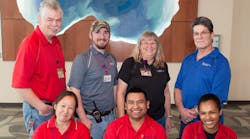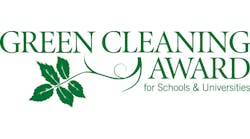GCA Silver Award Higher Education: University of Wisconsin–Madison, Division of Housing, Madison, Wisconsin
Program Information
Total number of students: 7,500 residents
Total square footage maintained: 1,699,272 (29 res. halls)
Total number of custodians: 95
Total annual cleaning budget: $570,000 (not including labor)
Green cleaning team members: Jodi Krause, Jason Rittel, Asst. Dirs. of Housekeeping; Sean Veselsky, Oleg Kizimenko, Cust. Svcs. Supervisors; Tony Owens, Dave Libert, Guy Lauver, James Manske, Asst. Bldg. Supervisors; Mary Tagliarino, Cust. Lead; Unisource Worldwide Inc., City Supply Corp., Janitorial Prod. Dist.; Richard Leigh, Jeanne Schrenk, Cust. Leads; Maria Alvarez, Miguel Garcia, Eileen Billman, Lakchung Lama, Tyeshea West, Brooke Danforth, Ken Shafer, Amina Aziz, Craig Rice, Nicole Davis, Silvia Diaz, Aaron Smeaton, Custodians
The University Housing green cleaning program formally started in 2011 with the change of the largest chemicals and the delivery method of those chemicals. Two of the largest chemicals were replaced with chemicals that are Green Seal-certified. Incorporated into that change were the installation of dilution stations and the replacement of ordering chemicals in bulk. They wanted a safer delivery method for staff as well as customers.
In order to change chemicals, it was vital to have the support of the staff and the residents. Testing of any new chemicals is done by the custodial staff. They give their feedback on several areas, and the results are tracked and kept on file. Custodial staff and supervisors also communicate with residents or their representatives through conversations and a Residence Hall Advisory Board, paying attention to any concerns surrounding the chemicals or equipment used in residence halls.
The next step is to move away from chemical cleaning wherever possible. They have installed a water-based cleaning system in 15 of buildings and have removed glass cleaners, general-purpose cleaners and disinfectants for daily use. Before taking this step, they used a handheld system and tested the cleaning results against the current disinfectant cleaner behind more than a dozen staff. Using an ATP tester, they were able to get soil counts before and after cleaning bathrooms with a disinfectant and repeated the exact same steps to get soils counts before and after cleaning with charged water. They are monitoring all results and are looking to install the system in all residence halls if results continue to show marked improvement in the cleanliness of surfaces.
University Housing continuously works to minimize the impact of the cleaning operations on the environment, including creating a sea salt-based bathroom cleaner, which is used on a weekly basis to clean the resident bathrooms. Custodians use microfiber technology to increase dusting efficiency; dry or damp microfiber cloth is effective for removing finger marks on painted, polished and glass surfaces. Other initiatives range from using as many Green Seal chemicals as possible, purchasing equipment that aligns with ergonomic and green criteria, creating a system for students to recycle and donate items (carpets, furniture, etc.) they no longer want at the end of the academic year, composting in several residence halls, and using only recycled materials whenever possible. Carpets are extracted using steam extractors– using only water to remove stains. All of the room and common area trash and recycling containers are clearly labeled so that they can increase awareness as well as reduce waste.
They use the Association of Physical Plant Administrators (APPA) Levels of Cleaning Standards in order to train and evaluate custodial staff in cleaning expectations. Training instruction is hands-on with all techniques and products demonstrated in one-on-one or small group sessions. The training program incorporates instructional materials provided by product and equipment vendors, as well as a detailed cleaning manual. Custodial staff are informed of the health benefits of the Green Cleaning Program and become aware that the changes from traditional cleaning procedures are not dramatic. Supervisors receive additional training in green cleaning principles in order to be able to deliver positive reinforcement to custodians and to encourage exploration of additional opportunities. Moreover, custodial staff and supervisors receive additional job-specific training on occupational and environmental safety issues. This hands-on training is provided by the University of Wisconsin - Department of Environmental Health and Safety’s Occupational Health Training Program.
UW-Madison has several sustainability initiatives; most notable among them is the We Conserve program. Housing takes an active role in working with campus partners to reduce waste, standardize chemical and consumable item purchases, and reuse or recycling all materials possible. Housing serves as a role model in areas including composting, recycling and reduced chemical cleaning.
On a monthly basis, custodian inspections are performed to evaluate and maintain the cleaning standards that are expected. Using the ATP meter as part of these inspections is crucial to ensuring that the cleaning results stay at a high level. The initial results have been documented, and they will continue to gather and record results. Gathering feedback from staff also is a vital component to determining results. Staff using the ionized water system report time savings and more efficient use of time, less reaction to the product as there are no chemical reactions to skin, eyes, or nose, and an overall cleaner appearance of surfaces.
There are several policies and processes in which they engage staff, residents, visitors and campus partners. UW Housing Housekeeping supports Product, Equipment, & Testing (PET) Committee in the continued discussion and decisions to research, introduce, test, and monitor use of new or better cleaning materials such as chemicals and equipment. This committee includes staff as well as supervisors and an assistant director of the housekeeping. The housekeeping director, assistant directors and supervisors attend meetings of the Resident Hall Advisory Board (RHAB) throughout the academic year in order to hear and address feedback or concerns of residents, including those regarding cleaning and equipment provided to the residents. Housekeeping assistant directors are actively involved with campus groups such as We Conserve and the Vice Chancellor for Administration’s Maintenance and Repair Operations (MRO) group. The We Conserve group has been instrumental in recycling initiatives and education throughout the UW-Madison campus. The MRO group consists of representative from all UW Departments and addresses financial savings through standardizing the cleaning and maintenance supplies across campus in accordance with the campus sustainability initiatives.
As active participants in the campus MRO group, Housing shares ideas and results of our cleaning methods. Communications sent to residents and their families as well as summer conference guests include information on recycling efforts. They post educational information within the residence halls in areas accessible to the public.
In 2012, Housing applied to have its newest building, Aldo Leopold Hall, LEED-certified. Leopold Hall contains a greenhouse on the top floor of the building. There are several ways they will communicate the importance of how they green clean via discussion and written pieces from the residence life and housekeeping staff. As a part of the greenhouse, it is possible to offer a for-credit academic course for residents of this building that examines the importance of green cleaning when striving to live a green lifestyle.

